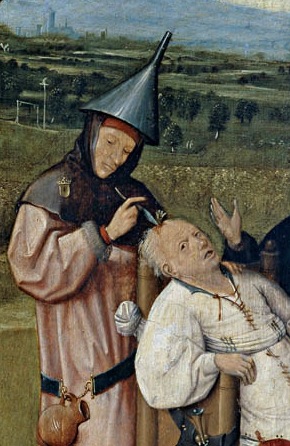
Hieronymus Bosch was a Dutch/Netherlandish painter from Brabant. He is one of the most notable representatives of the Early Netherlandish painting school. His work, generally oil on oak wood, mainly contains fantastic illustrations of religious concepts and narratives. Within his lifetime his work was collected in the Netherlands, Austria, and Spain, and widely copied, especially his macabre and nightmarish depictions of hell.

Pieter Bruegelthe Elder was the most significant artist of Dutch and Flemish Renaissance painting, a painter and printmaker, known for his landscapes and peasant scenes ; he was a pioneer in making both types of subject the focus in large paintings.

The Groeningemuseum is a municipal museum in Bruges, Belgium, built on the site of the medieval Eekhout Abbey.

The Garden of Earthly Delights is the modern title given to a triptych oil painting on oak panel painted by the Early Netherlandish master Hieronymus Bosch, between 1490 and 1510, when Bosch was between 40 and 60 years old. It has been housed in the Museo del Prado in Madrid since the year 1939.

The Temptation of Saint Anthony is an often-repeated subject in the history of art and literature, concerning the supernatural temptation reportedly faced by Saint Anthony the Great during his sojourn in the Egyptian desert. Anthony's temptation is first discussed by Athanasius of Alexandria, Anthony's contemporary, and from then became a popular theme in Western culture.
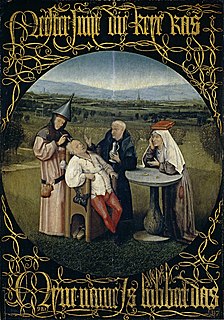
Cutting the Stone, also called The Extraction of the Stone of Madness or The Cure of Folly, is a painting by Hieronymus Bosch, displayed in the Museo del Prado in Madrid, completed around 1494 or later.
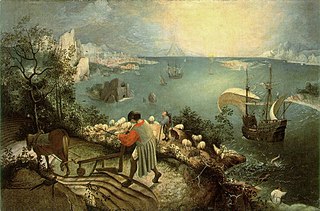
Dutch and Flemish Renaissance painting represents the 16th-century response to Italian Renaissance art in the Low Countries. These artists, who span from the Antwerp Mannerists and Hieronymus Bosch at the start of the 16th century to the late Northern Mannerists such as Hendrik Goltzius and Joachim Wtewael at the end, drew on both the recent innovations of Italian painting and the local traditions of the Early Netherlandish artists. Antwerp was the most important artistic centre in the region. Many artists worked for European courts, including Bosch, whose fantastic painted images left a long legacy. Jan Mabuse, Maarten van Heemskerck and Frans Floris were all instrumental in adopting Italian models and incorporating them into their own artistic language. Pieter Brueghel the Elder, with Bosch the only artist from the period to remain widely familiar, may seem atypical, but in fact his many innovations drew on the fertile artistic scene in Antwerp.
Death and the Miser is a Northern Renaissance painting by Hieronymus Bosch produced between 1490-1516 in Northern Europe. The piece was originally part of a triptych, but the center piece is missing. It is a memento mori painting, which is meant to remind the viewer of the inevitability of death and the futility of the pursuit of material wealth, illustrating the sin of greed. There is still debate about the exact symbolism of the man and the objects in the foreground. Bosch was influenced by the Ars moriendi, religious texts that instructed Christians how to live and die. It is currently held in the National Gallery of Art in Washington, D.C.

Ascent of the Blessed is a Hieronymus Bosch painting made between 1505 and 1515.

Christ Carrying the Cross is a painting attributed to a follower of Hieronymus Bosch. It was painted in the early 16th century, presumably between 1500 and 1535. The work is housed in the Museum of Fine Arts in Ghent, Belgium.
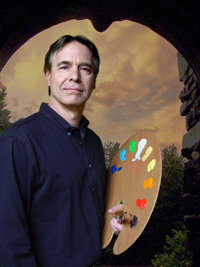
Thomas E. Breitenbach is a self-taught American artist best known for his painting Proverbidioms, a raucous and comical depiction of over 300 common proverbs and clichés. He also collaborated with Jim Morrison of The Doors, shortly before Morrison's death, on a painting intended for use on his An American Prayer album. Breitenbach studied architecture and fine arts at the University of Notre Dame, before leaving to become the youngest person to receive the Rome Prize Fellowship in visual arts. Breitenbach declined the second year of the fellowship and, inspired by the castles and museums of Europe, returned home determined to build a castle-studio to house his art and eventually become a museum. During the planning stages he painted Proverbidioms and later published it.
The Art Museum of Estonia was established in 1919. Originally based in Kadriorg Palace, the museum has expanded across several sites and today exhibits both international and local art works. At the end of the 1970s, in the 1980s the first branches of the Art Museum of Estonia were founded. Starting in 1995, all of the branches offer different educational programmes for children and young people. In 1996 the exhibition hall on the first floor of Rotermann Salt Storage was opened; this branch was closed in May 2005.

The Fall of the Rebel Angels is an oil-on-panel art piece painted in 1562 by the Netherlandish Renaissance artist, Pieter Bruegel the Elder. The painting is 117cm x 162cm and is currently held in the Royal Museums of Fine Arts of Belgium in Brussels. The Fall of Rebel Angels depicts Lucifer along with the other fallen angels that have been kicked out of heaven. Angels are falling from the sun in a stacked manner along with ungodly creatures that Bruegel has created. This piece by Bruegel was previously thought to be a Hieronymus Bosch piece. Bruegel was influenced by a variety of artists such as Albrecht Dürer, Frans Floris I, and Hieronymus Bosch. He also got ideas for the creation of his creatures in his previous works, The Last Judgement and Mad Meg . The painting is still relevant today in popular culture today.
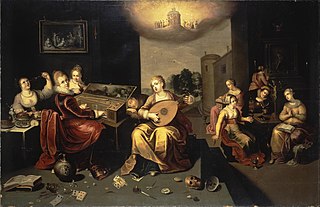
Hieronymus Francken the Younger or Hieronymus II was a Flemish painter and one of the most prominent members of the large Francken family of artists. Along with his brother Frans Francken II he played an important role in the development of new genres in Flemish art in the early 17th century.

The Triptych of Temptation of St. Anthony is an oil painting on wood panels by the Early Netherlandish painter Hieronymus Bosch, dating from around 1501. The work tells the story of the mental and spiritual torments endured by Saint Anthony the Great, one of the most prominent of the Desert Fathers of Egypt in the late 3rd and early 4th centuries. The Temptation of St. Anthony was a popular subject in Medieval and Renaissance art. In common with many of Bosch's works, the triptych contains much fantastic imagery. The painting hangs in the Museu Nacional de Arte Antiga in Lisbon.

Het Noordbrabants Museum is an art museum in 's-Hertogenbosch, Netherlands.
Jheronimus Bosch—Visions of Genius was a 2016 art exhibition at the Noordbrabants Museum in 's-Hertogenbosch, The Netherlands, about the work of Hieronymus Bosch, a native of 's-Hertogenbosch.

Frans Verbeeck or Frans Verbeeck the Elder was a Flemish painter and draughtsman to whom have been attributed a number of works depicting fantastical and grotesque scenes carrying a moralizing intent. He was a member of an important family of artists operating a large workshop with various branches in Mechelen. As it is not always possible to attribute a particular artwork to one or the other family member due to compositional, stylistic, and iconographic similarities, it has been suggested that the works should be attributed to the 'Verbeeck group'. The works were typically executed in tempera or watercolor on linen.

A cranial drill, also known as a craniotome, is a tool for drilling simple burr holes (trepanation) or for creating larger openings in the skull. This exposes the brain and allows operations like craniotomy and craniectomy to be done. The drill itself can be manually or electrically driven, and primarily consists of a hand piece and a drill bit which is a sharp tool that has the form similar to Archimedes screw, this instrument must be inserted into the drill chuck to perform holes and remove materials. The trepanation tool is generally equipped with a clutch which automatically disengages once it touches a softer tissue, thus preventing tears in the dura. For larger openings, the craniotome is a surgical instrument that has replaced manually pulled saw wires in craniotomies from the 1980s.
Christ Carrying the Cross refers to Jesus's journey to his crucifixion.
